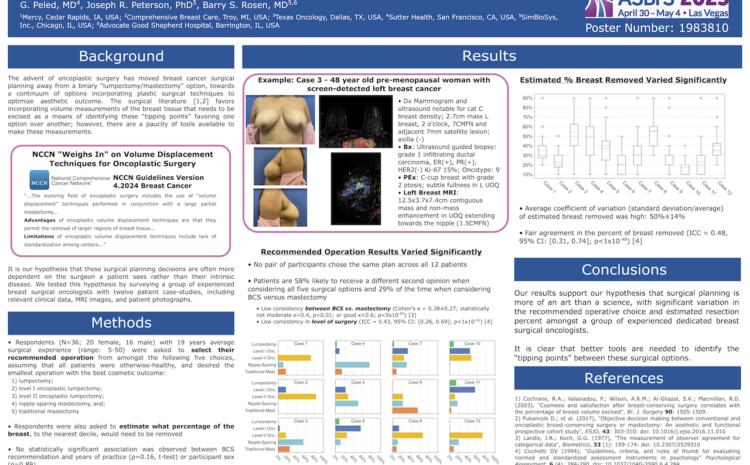Authors: Joseph R. Peterson, PhD1, Brandy Wolff1, Bradley Feiger, PhD1, Vignesh Kannan, MS1, Katrina Rabinovich, MD2, Stefanie A. Woodard, DO3, Kathryn W. Zamora, MD, MPH3 1SimBioSys, Inc., Chicago, IL, USA; 2Mount Sinai Medical Center, Miami, FL, USA; 3University of Alabama-Birmingham,…
Authors: Vincent J. Reid, MD, FACS1, Linsey P. Gold, DO, FACOS, FACS2, Eric A. Brown, MD, FACS2, Allison A. DiPasquale, MD3, Anne G. Peled, MD4, Joseph R. Peterson, PhD5, Barry S. Rosen, MD5,6 1Mercy, Cedar Rapids, IA, USA; 2Comprehensive Breast…
Decision-making for early (Stages 1-3) breast cancer (eBC) surgery is complex and highly personal, requiring discussions between patients and multiple physicians. Shared decision-making (SDM) is an accepted process but its use by physicians is low due to a lack of time, incentives, complicated applications, and few communication tools. SimBioSys…
Neoadjuvant therapy (NAT) has become a standard-of-care (SOC) for patients diagnosed with locally advanced or early-stage breast cancer. While pathological complete response (pCR) is commonly used to measure NAT effectiveness, patients who do not achieve pCR may still benefit from NAT, depending on the tumor’s response. A reduction…
The decision-making process regarding breast cancer treatment options, specifically breast conserving surgery (BCS) versus mastectomy, is a complex and sensitive matter that takes into account the patient’s preferences and the surgeon’s clinical opinion. A range of anatomical factors, such as tumor size, breast size,…
Traditionally, multi-focal breast cancer results in mastectomy. The Alliance Trial offers a paradigm shift in surgical options available for multi-focal breast cancer patients in the context of adjuvant chemotherapy. In the trial, patients with multi-focal disease (2 or 3 tumors) who underwent breast conservation…
Metabolic reprogramming and tumor angiogenesis are two tightly linked hallmarks of cancer. Regions of high metabolic activity within a tumor can become hypoxic or nutrient starved, eliciting a cascade of pro-angiogenic signals that can lead to increased tumor perfusion and in turn greater metabolic…
As new antibody drug conjugates are developed, the question of which specific patients will respond to these therapies remains. This work develops a spatial PK/PD model for the antibody drug conjugate trastuzumab emtansine, T-DM1, and explores the relationship between HER2 (target) expression and other individual features of the tumor microenvironment…
We developed an ensembled suite of convolutional neural networks (core components of SimBioSys TumorSight) that segmented tumor and other tissues, in and around the breast (chest, adipose, gland, vasculature, skin). We sought to validate model results against the expertise of…
Here, we applied an integrative computational approach to develop the IOScope biomarker, which predicts IO response in ESBC.



